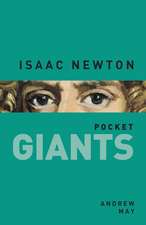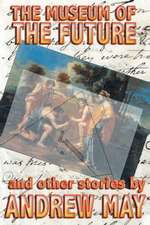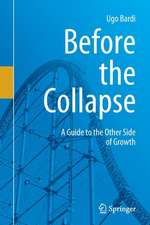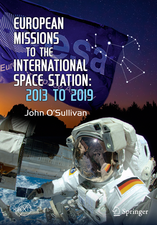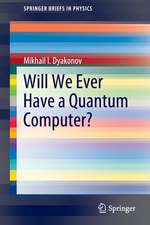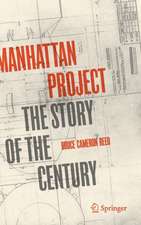The Science of Sci-Fi Music: Science and Fiction
Autor Andrew Mayen Limba Engleză Paperback – iul 2020
Creating electronic sounds, in the early days, required a well-equipped laboratory and an understanding of acoustic theory. Composition became increasingly “algorithmic”, with many composers embracing the mathematics of set theory. The result was some of the most intellectually challenging music ever written – yet also some of the best known, thanks to its rapid assimilation into sci-fi movies and TV shows, from the electronic scores of Forbidden Planet and Dr Who to the other-worldly sounds of 2001: A Space Odyssey.
This book takes a close look at the science behind "science fiction" music, as well as exploring the way sci-fi imagery found its way into the work of musicians like Sun Ra and David Bowie, and how music influenced the science fiction writings of Philip K. Dick and others.
Din seria Science and Fiction
-
 Preț: 129.05 lei
Preț: 129.05 lei -
 Preț: 104.10 lei
Preț: 104.10 lei -
 Preț: 103.05 lei
Preț: 103.05 lei -
 Preț: 104.92 lei
Preț: 104.92 lei - 5%
 Preț: 102.99 lei
Preț: 102.99 lei -
 Preț: 105.96 lei
Preț: 105.96 lei -
 Preț: 215.30 lei
Preț: 215.30 lei -
 Preț: 162.50 lei
Preț: 162.50 lei -
 Preț: 146.18 lei
Preț: 146.18 lei - 5%
 Preț: 218.95 lei
Preț: 218.95 lei -
 Preț: 128.64 lei
Preț: 128.64 lei -
 Preț: 150.92 lei
Preț: 150.92 lei -
 Preț: 115.46 lei
Preț: 115.46 lei -
 Preț: 111.50 lei
Preț: 111.50 lei -
 Preț: 101.01 lei
Preț: 101.01 lei -
 Preț: 103.91 lei
Preț: 103.91 lei -
 Preț: 337.51 lei
Preț: 337.51 lei -
 Preț: 131.12 lei
Preț: 131.12 lei -
 Preț: 141.41 lei
Preț: 141.41 lei -
 Preț: 484.79 lei
Preț: 484.79 lei -
 Preț: 182.09 lei
Preț: 182.09 lei -
 Preț: 106.14 lei
Preț: 106.14 lei -
 Preț: 147.23 lei
Preț: 147.23 lei -
 Preț: 183.84 lei
Preț: 183.84 lei -
 Preț: 109.86 lei
Preț: 109.86 lei -
 Preț: 207.39 lei
Preț: 207.39 lei -
 Preț: 72.68 lei
Preț: 72.68 lei -
 Preț: 148.46 lei
Preț: 148.46 lei -
 Preț: 154.46 lei
Preț: 154.46 lei -
 Preț: 146.58 lei
Preț: 146.58 lei -
 Preț: 179.68 lei
Preț: 179.68 lei -
 Preț: 184.72 lei
Preț: 184.72 lei -
 Preț: 149.48 lei
Preț: 149.48 lei -
 Preț: 133.99 lei
Preț: 133.99 lei -
 Preț: 149.45 lei
Preț: 149.45 lei -
 Preț: 128.86 lei
Preț: 128.86 lei -
 Preț: 146.36 lei
Preț: 146.36 lei - 20%
 Preț: 225.94 lei
Preț: 225.94 lei -
 Preț: 214.22 lei
Preț: 214.22 lei -
 Preț: 190.49 lei
Preț: 190.49 lei -
 Preț: 168.11 lei
Preț: 168.11 lei -
 Preț: 174.83 lei
Preț: 174.83 lei -
 Preț: 111.33 lei
Preț: 111.33 lei -
 Preț: 183.23 lei
Preț: 183.23 lei -
 Preț: 147.28 lei
Preț: 147.28 lei -
 Preț: 173.75 lei
Preț: 173.75 lei
Preț: 152.76 lei
Nou
Puncte Express: 229
Preț estimativ în valută:
29.23€ • 30.20$ • 24.33£
29.23€ • 30.20$ • 24.33£
Carte disponibilă
Livrare economică 04-18 martie
Preluare comenzi: 021 569.72.76
Specificații
ISBN-13: 9783030478322
ISBN-10: 3030478327
Pagini: 153
Ilustrații: V, 153 p. 40 illus., 29 illus. in color.
Dimensiuni: 155 x 235 x 13 mm
Greutate: 0.23 kg
Ediția:1st ed. 2020
Editura: Springer International Publishing
Colecția Springer
Seria Science and Fiction
Locul publicării:Cham, Switzerland
ISBN-10: 3030478327
Pagini: 153
Ilustrații: V, 153 p. 40 illus., 29 illus. in color.
Dimensiuni: 155 x 235 x 13 mm
Greutate: 0.23 kg
Ediția:1st ed. 2020
Editura: Springer International Publishing
Colecția Springer
Seria Science and Fiction
Locul publicării:Cham, Switzerland
Cuprins
Alien Sounds.- Musical Mathematics.- The Electronic Revolution.- Scientific Music.- Science Fiction and Music Culture.- Speculations on a Musical Theme.
Recenzii
“This book makes satisfying reading. … the book is elegantly written, thought provoking and entertaining. … I thought I knew this subject well, but was surprised and delighted to find lots in the book that was quite new to me. Highly recommended.” (Steve Marshal, Fortean Times, Issue 412, 2021)
“The book offers a highly accessible and engaging introduction to the science of sci-fi music, with technical detail skilfully balanced with fascinating anecdotes about the people and technological developments that have enabled composers to respond to the challenge of creating otherworldly and alien-sounding music.” (Kim Kenobi, London Mathematical Society Newsletter, newsletter.lms.ac.uk, Issue 494, May, 2021)
“If either the development of electronic music and avant garde musical techniques or science fiction is an interest, this book is likely to pique your attention. If both interest you, this is a book that has to be added to your collection.” (Popular Science, popsciencebooks.blogspot.com, July 17, 2020)
“The book offers a highly accessible and engaging introduction to the science of sci-fi music, with technical detail skilfully balanced with fascinating anecdotes about the people and technological developments that have enabled composers to respond to the challenge of creating otherworldly and alien-sounding music.” (Kim Kenobi, London Mathematical Society Newsletter, newsletter.lms.ac.uk, Issue 494, May, 2021)
“If either the development of electronic music and avant garde musical techniques or science fiction is an interest, this book is likely to pique your attention. If both interest you, this is a book that has to be added to your collection.” (Popular Science, popsciencebooks.blogspot.com, July 17, 2020)
Notă biografică
Andrew May obtained a PhD in astrophysics from the University of Manchester in 1982 and is an experienced and versatile professional, with a career spanning academia, government and private industry. Since 2011 he has been working as a freelance writer and defence consultant. He has a wide range of interests and has written both authoritatively and entertainingly on the physical sciences, military technology, British history, science fiction, New Age beliefs and the paranormal. He has recently published Pseudoscience and Science Fiction (2017), Rockets and Ray Guns: The Sci-Fi Science of the Cold War (2018) and Fake Physics: Spoofs, Hoaxes and Fictitious Science (2019) with Springer.
Textul de pe ultima copertă
The 20th century saw radical changes in the way serious music is composed and produced, including the advent of electronic instruments and novel compositional methods such as serialism and stochastic music. Unlike previous artistic revolutions, this one took its cues from the world of science.
Creating electronic sounds, in the early days, required a well-equipped laboratory and an understanding of acoustic theory. Composition became increasingly “algorithmic”, with many composers embracing the mathematics of set theory. The result was some of the most intellectually challenging music ever written – yet also some of the best known, thanks to its rapid assimilation into sci-fi movies and TV shows, from the electronic scores of Forbidden Planet and Dr Who to the other-worldly sounds of 2001: A Space Odyssey.
This book takes a close look at the science behind "science fiction" music, as well as exploring the way sci-fi imagery found its way into the work of musicians like SunRa and David Bowie, and how music influenced the science fiction writings of Philip K. Dick and others.
Creating electronic sounds, in the early days, required a well-equipped laboratory and an understanding of acoustic theory. Composition became increasingly “algorithmic”, with many composers embracing the mathematics of set theory. The result was some of the most intellectually challenging music ever written – yet also some of the best known, thanks to its rapid assimilation into sci-fi movies and TV shows, from the electronic scores of Forbidden Planet and Dr Who to the other-worldly sounds of 2001: A Space Odyssey.
This book takes a close look at the science behind "science fiction" music, as well as exploring the way sci-fi imagery found its way into the work of musicians like SunRa and David Bowie, and how music influenced the science fiction writings of Philip K. Dick and others.
Caracteristici
Of the many books on “science fiction music”, this is the only one that looks at the science aspect of the music itself Gives an insight into the way music is composed, and why it sounds the way it does, in an engaging way that avoids traditional music theory or jargon Shows the surprising relationships between two disparate styles that arose in the 20th century – avant-garde art music and popular sci-fi movies



